TODAY: Plenty of sun, quite pleasant. Dew point: 59. Winds: South 10-15. High: 83
MONDAY NIGHT: Mostly clear and mild. Low: 71
TUESDAY: Steamy sun, few strong/severe T-storms possible. Dew point: 73. Heat Index: near 100. High: 93
WEDNESDAY: Turning sunny, less humid. Dew point: 54. Low: 69. High: 84
THURSDAY: Sunny, dry start for State Fair. Dew point: 61. Low: 63. High: 85
FRIDAY: Less sun, few T-storms late? Dew point: 66. Low: 65. High: 83
SATURDAY: Some sun, scattered T-storms. Dew point: 68. Low: 67. High: 84
SUNDAY: More numerous showers and T-storms. DPew point 70. Low: 69. High: 83
79 F. high in the Twin Cities Sunday, trace of rain at MSP.
93 F. high predicted for Tuesday, dew point rising to 73 could make it feel like 100 by late afternoon.
Slight severe storm risk over southeastern Minnesota by Tuesday afternoon/evening.

Hot Weather Factoid: Topeka has experienced 21 days over 100 this year; that matches the entire total for Des Moines since 1983. Wichita has suffered thru 44 days > 100 F, which is Des Moines's total since 1977 - Iowa Environmental Mesonet.
Portland, Oregon topped 90 degrees Saturday for the first time this year while also setting a new record high temperature of 96.
48 days above 100 at Shreveport, Louisiana, breaking the old record of 47 days set in 1881.
Possible EF-3 Tornado near Toronto (Goderich) around 4 pm Sunday. This may wind up being the first EF-3 tornado to hit Ontario, Canada in 15 years.
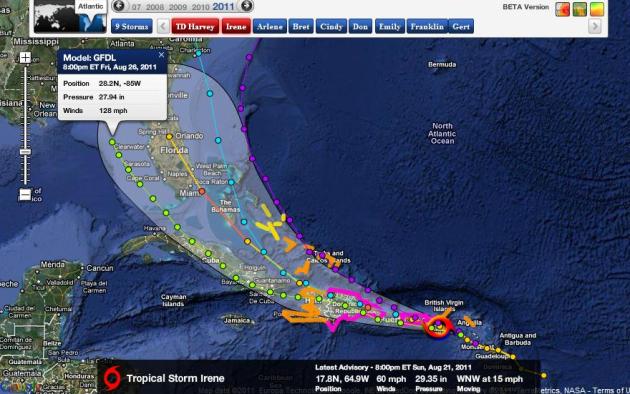
"Irene", A Major Hurricane? Right now odds favor that Tropical Storm Irene will take a track that brushes the east coast of Florida later this week, a possible direct strike on the Carolinas. A few models bring Irene into the Gulf of Mexico. The GFDL model prints out 128 mph. sustained winds in the eastern Gulf of Mexico by Friday evening. It's still too early to know exactly where Irene will go (margin of error is plus or minus 200 miles at this point). Residents from the Gulf of Mexico to Florida on north to the Outer Banks of North Carolina should monitor the storm, prepare an action plan, and be ready to evacuate if the orders are given later this week.
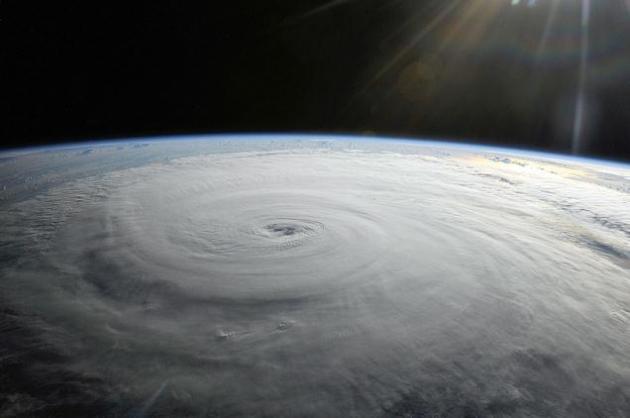
"...Insurance industry data show the costs of disasters are rising, even when adjusted for inflation. That's largely due to concentrated building of homes and businesses in vulnerable places, Nutter said."The reality is that our society has moved increasingly to areas with the greatest exposure to natural catastrophes along our coasts and rivers and invaded the natural landscape in areas susceptible to wildfire and drought,"....The value of developments along the U.S. coasts from New York to Florida and around the Gulf of Mexico to Texas exceeds $9 trillion, Nutter told CNN; $2 trillion of that value is in Florida alone, he said. More stringent building codes and restrictions on development in high-risk areas are essential to curtailing losses of life and property, Nutter said." - CNN article below on this year's record-tying number of billion dollar disasters. (photo of Hurricane Danielle in 2010 courtesy of NASA).

Will Aliens Destroy Earth Because Of Run-Away Greenhouse Gas Emissions? Personally, I believe this is a low-probability event, but (bored?) scientists are actually thinking about this stuff. Details from the U.K. Guardian.

"...All this thawing of ancient permafrost could eventually release mind-boggling stores of carbon that have been trapped inside frozen materials for eons --potentially turbo-charging the greenhouse effect with even more CO2 and methane. "It is estimated that the permafrost contains twice the amount of carbon that is currently in our atmosphere," said Gooseff, told the society in his remarks." - from an article below at Alaska Dispatch, focusing on rapid changes in the Arctic and implications of melting permafrost.

"...Climate is average weather, which is more predictable than day-to-day and hour-to-hour weather changes. Weather behavior is chaotic and often difficult to predict beyond a week or so into the future. By comparison, climate is largely determined by global and regional geophysical processes that change slowly. Hence, if these factors are properly understood and predictable, then the climate can be forecast far into the future with a significant degree of confidence." - from an article below describing lingering skepticism about climate change from many of America's TV meteorologists. (photo courtesy of global-greenhouse-warming.com).

"...The findings are cause for concern, according to the authors, because cohabiting families are on the rise: there are twelve times as many today as there were in the 1970s." - Huffington Post article below on a new study that raises potential concerns about the children of co-habitating adults.
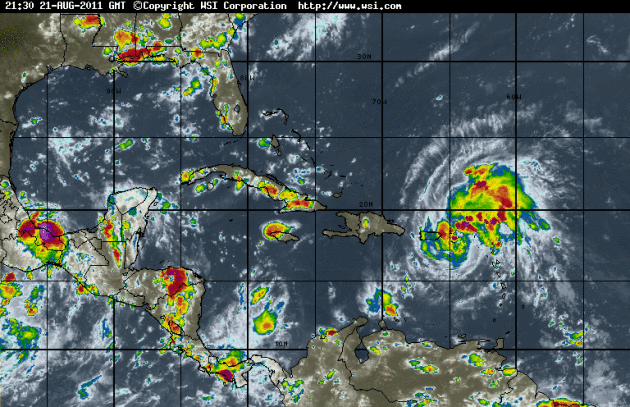
Tropical Storm Irene. Sunday night's enhanced IR loop showed the storm becoming better organized over the U.S. Virgin Islands, packing sustained winds of 60 mph. Imagery courtesy of WSI.

"Irene's" Projected Track. Models take a strong tropical storm or possible hurricane very close to Florida - possible landfall over the Carolinas. Data courtesy of my.sfwmd.gov and NHC
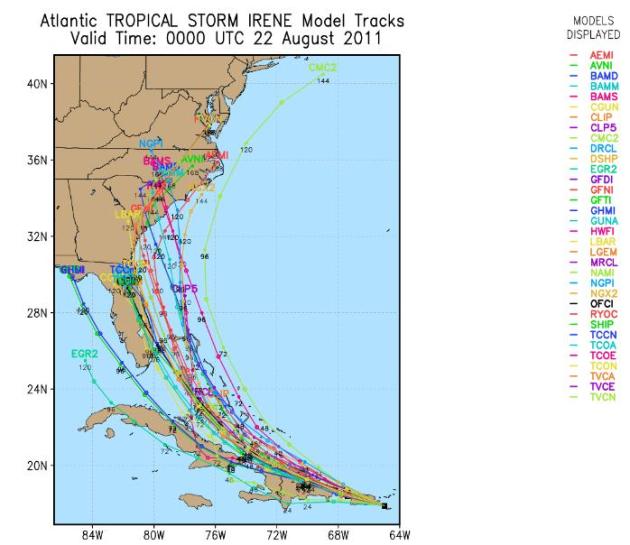
A Very Close Call For Florida. The models are all in fairly good agreement, what meteorologist refer to as "continuity". One concern: the center of "Irene" will be passing over very warm Gulf Stream waters (temperatures anywhere from 84-87 F) which may result in rapid intensification. Will that be enough to compensate for dry air aloft and some level of wind shear? Too early to say, but residents from the Outer Banks of North Carolina southward to Miami will want to keep very close tabs on Irene. Map courtesy of flhurricane.com.
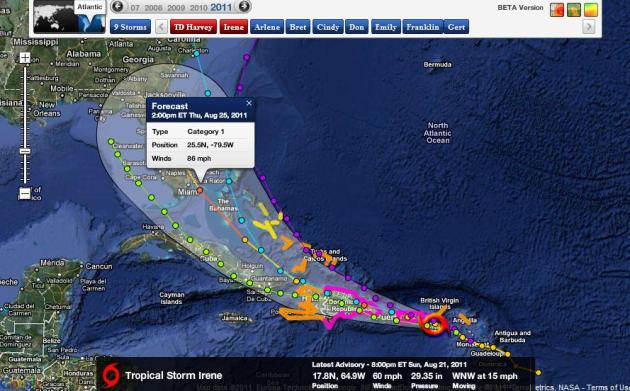
Scenario #1: Minor Hurricane. This model scenario brings "Irene" into south Florida near Miami by 2 pm Thursday with sustained winds of 86 mph, weakened after passing over Hispaniola, but capable of regenerating into a category 1 hurricane before brushing Florida.

Scenario #2. Major Hurricane In The Gulf Of Mexico. Although this outcome is less likely (most of the models curve Irene to the northwest, toward the Carolina coast), it's much more problematic. The reason: water temperatures in the Gulf of Mexico are very warm: 85 to 88 F, high-octane fuel that could result in rapid intensification. The latest GFDL model track (pictured in green above) shows Irene packing 128 mph sustained winds in the eastern Gulf of Mexico by Friday evening at 8 pm.
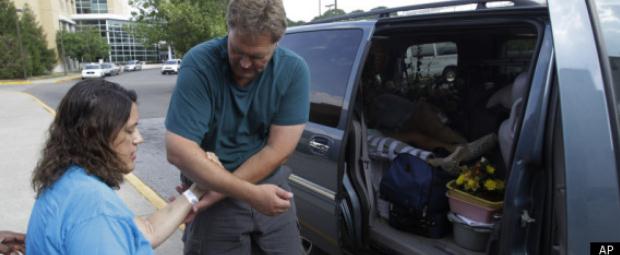
Indiana Stage Collapse. Survivors Recall Aftermath. I can't begin to imagine the scenes of horror in the immediate aftermath of the Indiana State Fair stage collapse a couple of Saturdays ago. Huffington Post Chicago has more details on what really happened: "INDIANAPOLIS — The skies to the west grew darker as Dr. Rob Klinestiver and his 12-year-old daughter waited for country stars Sugarland to take the stage at the Indiana State Fair. Klinestiver pointed to the scaffolding supporting the stage's roof, lights and other equipment. "Hey, you know, there's a small chance that if it gets really nasty that thing could even blow over," he told his daughter, Leah. "Dad, you're kind of freaking me out," she replied. He reassured her quickly: "I said, `Oh, never mind. It's a small chance.'" Moments later, a wind gust of 60 to 70 mph brought down the scaffolding. Happy chatter turned into screams of terror as thousands of pounds of metal and equipment tumbled into the crowd below. Four people died immediately. A fifth passed away hours later at a hospital, and a sixth died Friday. Dozens more were injured, some so severely it will take months for them to recover – if they ever do. As Indiana investigates whether the deaths and injuries could have been prevented, the survivors remain haunted by the sounds and images of that night. Many are still grappling with the capricious nature of the collapse, where mere inches determined who lived and who died."
Photo credit above: "Tim Brunn of Island Lake, Ill. helps is wife, Karen, into their van after he was released from Wishard Hospital in Indianapolis, Thursday, Aug. 18, 2011. Karen along with her son, Josh, were injured when a stage collapsed at the Indiana State Fair on Saturday. (AP Photo/Darron Cummings)"
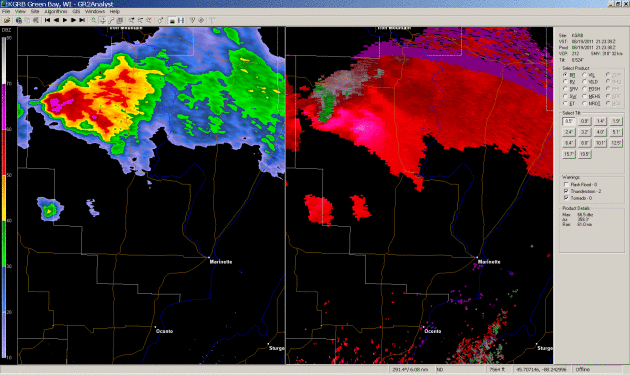
More On Last Friday's Wausaukee (Wisconsin) Tornado. Here is preliminary data on the northeastern Wisconsin tornado that resulted in at least one fatality, from the Green Bay office of the National Weather Service: "A severe thunderstorm produced a tornado over Marinette County near Wausaukee late in the afternoon on August 19, 2011. The twister flattened a mobile home, killing the occupant; another mobile home was heavily damaged. At least four other buildings sustained minor damage. Hundreds of trees were snapped or uprooted along the nearly eight mile long path of the storm. The tornado was rated EF1 on the Enhanced Fujita Scale, with maximum winds estimated at 100 to 105 mph."

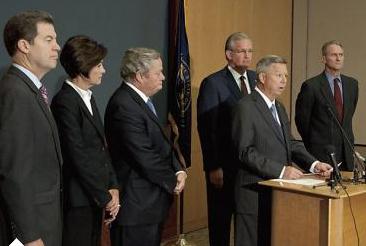
Governors Request Missouri River Flood-Plan Update. The flooding on the Missouri is unprecedented in its scope and duration - going on 6 months now. Some have speculated that the Army Corp of Engineers could have done a better job "controlling" the flooding along the river - dams and levees can only do so much when you're dealing with a). record winter snowmelt and b). almost continuous heavy rain from persistent summer showers and T-storms. The San Francisco Chronicle has more: "Governors from several states hit by this year's historic overflowing of the Missouri River pledged Friday to work together for the first time to persuade the U.S. Army Corps of Engineers to make flood control its top priority for the nation's longest river. The top executives from seven states signed a letter during a meeting in Omaha that asks the federal agency to review its river management practices and make recommendations to improve flood control along the 2,341-mile-long river. The corps manages the river, which flows from Montana, through North Dakota, South Dakota, Wyoming, Nebraska, Kansas, Iowa and Missouri."
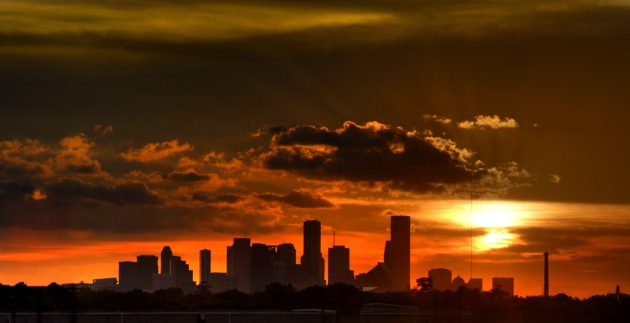
Houston Databank:
- MOST CONSECUTIVE 100-DEGREE DAYS AT HOUSTON (IAH):
(RECORDS SINCE 1889) - 1. 20 DAYS - ONGOING AS OF 8/20/2011
- 2. 14 DAYS - ENDING 7/19/1980
- MOST 100-DEGREE DAYS FOR AN ENTIRE SUMMER AT HOUSTON (IAH):
(RECORDS SINCE 1889) - 1. 32 DAYS - 1980
- 2. 31 DAYS - 2011 (ONGOING AS OF 8/20/2011)

Year Packed With Weather Disasters Has Brought Economic Toll To Match. The New York Times has the story: "Normally, three or four weather disasters a year in the United States will cause at least $1 billion in damages each. This year, there were nine such disasters. They included the huge snow dump in late January and early February on the Midwest and Northeast, the rash of tornadoes this spring across the Midwest and the more recent flooding of the Missouri and Souris Rivers. The disasters were responsible for at least 589 deaths, including 160 in May when tornadoes ripped through Joplin, Mo.
The nine weather events that have caused at least $1 billion in damages so far this year are:
¶Central/East Groundhog Day blizzard (Jan. 29-Feb. 3). This storm was tied to 36 deaths. The losses exceeded $2 billion.
¶Midwest/Southeast tornadoes (April 4-5). Nine people were killed. Total losses were more than $2 billion.
¶Southeast/Midwest tornadoes (April 8-11). Resulted in more than $2 billion in losses.
¶Midwest/Southeast tornadoes (April 14-16). Caused 38 deaths. Total losses are more than $2 billion.
¶Southeast/Ohio Valley/Midwest tornadoes (April 25-30). Caused 327 deaths. Losses total more than $9 billion.
¶Midwest/Southeast tornadoes (May 22-27). Caused 177 deaths. Total losses are more than $7 billion.
¶Southern Plains/Southwest drought, heat waves, wildfires. Direct losses are more than $5 billion.
¶Mississippi River flooding. At least two deaths and losses ranging from $2 billion to $4 billion.
¶Upper Midwest flooding. Losses estimated at $2 billion.
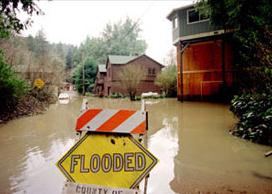
2011: Year Of Billion Dollar Disasters. The story from theindychannel.com and CNN: "The United States has already seen nine weather disasters this year that have caused $1 billion or more in damage, tying the record set in 2008. The total for all the disasters is about $35 billion."The year 2011 has already established itself in the record books as a historic year for weather-related disasters, and it is not over -- in fact, hurricane season is just getting under way," NOAA Deputy Administrator Kathryn D. Sullivan told the Senate Appropriations Committee in late July.Here are the other eight, according to NOAA, from most to least recent:Upper Midwest flooding, summerThe Missouri and Souris rivers flooded across the Upper Midwest. About 11,000 people were forced to evacuate Minot, North Dakota, and thousands of acres of farmland flooded along the Missouri. Five people were killed, and estimated losses exceed $2 billion and counting.Mississippi River flooding, spring-summerHeavy rain and melting snow in the Ohio Valley caused historic flooding along the Mississippi River and its tributaries. At least two people died, and the estimated economic loss ranges from $2 billion to $4 billion."
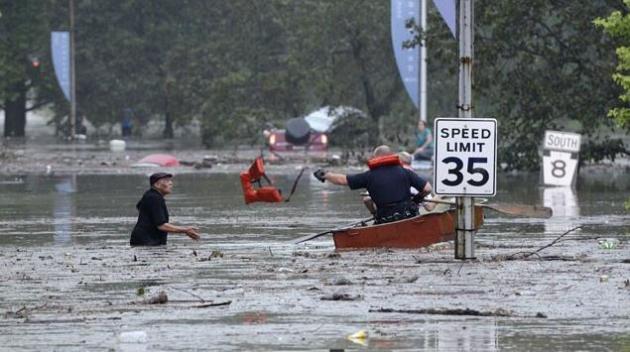
Flood Tips: What To Do If You're Driving In Rising Water. Pittsburgh recorded at least 4 flash flood-related deaths over the weekend, the result of people driving into flooded-out streets. It only takes 1-2 feet of rapidly moving water to turn your vehicle into a boat, swept downstream, with potentially tragic results. The Pittsburgh Post Gazette has more details: "More deaths occur each year due to flooding than from any other severe weather related hazard, according to the Federal Emergency Management Agency. The Centers for Disease Control report that over half of all flood-related drownings occur when a vehicle is driven into hazardous flood water. The next highest percentage of flood-related deaths is due to walking into or near flood waters. Many of the deaths occur in automobiles as they are swept downstream."

National Marriage Association "Why Marriage Matters" Study Says Cohabitating Parents Do Kids Harm. In what is sure to be a controversial report, a Huffington Post asks the question: are kids with cohabitating parents at greater risk than children whose parents are married? "Unmarried, cohabiting parents may be putting their kids at risk for a host of personal problems-- at least according to a new report from the University of Virgina's National Marriage Project and the Institute for American Values. But are the findings in the report really as straightforward as they seem? The report, released August 16 and entitled "Why Marriage Matters," pulls together findings from 18 scholars to argue that kids living in cohabiting households don't do as well socially, educationally and psychologically as kids living in intact married households. The authors point to a lack of stability in cohabiting relationships as one of the culprits: cohabiting couples with a child are more than twice as likely to break up before their child turns 12 as their married counterparts. That lack of stability--defined as the rotating crop of parent-like figures who transition in and out of kids' lives--is tied to school failure, behavior problems, drug use and loneliness. The effects are especially evident in children who experience several of these transitions."

Boomers Will Be Pumping Billions Into Anti-Aging Industry. The story from Huffington Post: "NEW YORK -- Baby boomers heading into what used to be called retirement age are providing a 70 million-member strong market for legions of companies, entrepreneurs and cosmetic surgeons eager to capitalize on their "forever young" mindset, whether it's through wrinkle creams, face-lifts or workout regimens. It adds up to potential bonanza. The market research firm Global Industry Analysts projects that a boomer-fueled consumer base, "seeking to keep the dreaded signs of aging at bay," will push the U.S. market for anti-aging products from about $80 billion now to more than $114 billion by 2015. The boomers, who grew up in a culture glamorizing youth, face an array of choices as to whether and how to be a part of that market. Anti-aging enthusiasts contend that life spans can be prolonged through interventions such as hormone replacement therapy and dietary supplements. Critics, including much of the medical establishment, say many anti-aging interventions are ineffective or harmful."


Cadillac's Huge-Tastic Convertible. No, it's not very green, it probably isn't very fuel-efficient at all, but (for a car-guy like me) this concept car from Cadillac is a thing of wonder. This proposed stretch-convertible is a 425 HP hybrid with 6 cylinders. More from CNN Money: "General Motors designers reached back to the massive Cadillac convertibles of the past to create the Ciel concept car, unveiled in California Thursday. Cadillac's last full-sized convertible was the 1985 El Dorado but this car suggests what a future version might look like. While this car might never see production, Cadillac designers are working on a new full-size flagship sedan for the brand and this car suggests some of the design direction for that car, GM said. "Large, expressive luxury is innate to Cadillac and the Ciel recalls that heritage, while suggesting where the brand can go in the future," Clay Dean, global design director for Cadillac, said in a statement."

Before The (Grinding) Accident. Step away from the power-tools, Paul. No, it wasn't a sanding accident, I was power-grinding the little nubs off 150 brick pavers up at the cabin last weekend. I was doing just fine until the LAST BRICK. Maybe I was getting tired, cocky or overconfident, but the blade caught on the brick and kicked back, shredding my right glove and cutting into my index finger. Why am I sharing my pain and embarrassment? As a cautionary tale. Thank God I was wearing safety goggles and heavy gloves, otherwise I'd be pointing at the weather map with a hook this week. Ugh.

Exhibit A. Yes, that's my (partly-shredded) right index finger, healing up, thank goodness. "You should have hired an expert Paul!" I know, but at some point you want to do stuff yourself and not always rely on other (professionals). Part of it was saving money, but I also wanted to prove I could do it myself. Almost got away with it, too. Sorry to share my mangled finger with you - but the public has a right to know....

Mostly-Fine Sunday. A few upper-level features sparked patchy clouds and showers (.18" rain at St. Cloud), but much of Minnesota experienced a nice Sunday, enough sun for 75 at Alexandria, 78 at St. Cloud, 79 in the Twin Cities and 83 at Redwood Falls. A "trace" of rain fell at MSP.

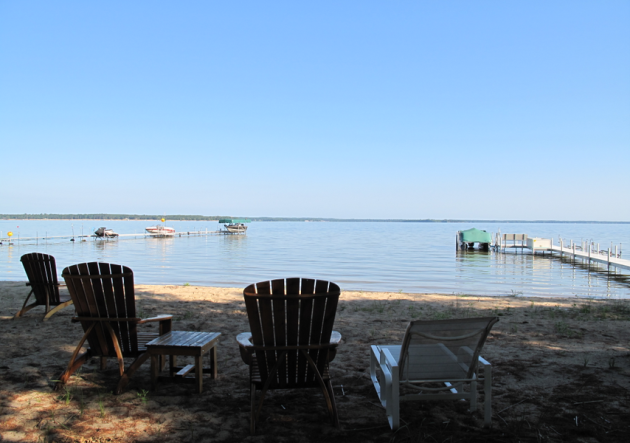
Cabin Rediscovered
My favorite quote: "Man plans, God laughs". Yep. We fixed up our cabin this year, thinking we'd put it on the market (great timing huh?) We got it so nice (hardwood floors, slate/granite bathroom) that my wife and I realized we were NUTS to part with this...gift. "Are we out of our minds? This is a great retreat for grandkids to come!" It took me a long time to figure out why people drive 2-4 hours to their up-north-escapes, but now I get it. A "Little Slice of Heaven" indeed.
Giving one forecast (for the entire state) is a bit ludicrous. Yesterday the sun was out up north, but a "jet streak", an upper level disturbance 3-6 miles aloft, sparked a narrow 75-mile-wide smear of clouds and light showers closer to the metro. Computer models do a good job with the big storms, 500-1,000 miles wide, but sometimes these "micro-scale" features slip thru the cracks & complicate the forecast.
While Florida braces for the possible arrival of "Irene", Minnesota experiences a string of 80s this week, 90 possible Tuesday as dew points rise into the 70s. Cooler, drier arrives Wednesday, but count on 80s for the MN State Fair; a risk of T-storms (and cheese curds) late Friday into Sunday.
Climate Stories...

The Environmental Divide: GOP Candidates Spar Over Climate Change. Here's an excerpt of an article from ABC News: "In the week since Texas Gov. Rick Perry launched his bid for the White House, he has exploded onto the national scene, firing off provocative comments, touting his "Texas miracle" and drawing shots from his fellow GOP candidates. The latest episode of candidate-on-candidate banter came this week after the increasingly-vocal Jon Huntsman shot back at Perry for comments the he made Wednesday that discounted global warming as a "scientific theory that has not been proven." Huntsman, who has supported emissions regulations to stave off global warming, took a jab at Perry via twitter, saying, "To be clear. I believe in evolution and trust scientists on global warming. Call me crazy." Despite their shared party affiliation, Huntsman and Perry stand on starkly different sides of the climate debate. As the governor of Utah, Huntsman pushed for cap-and-trade policies to limit carbon emissions, even appearing in a 2007 Environmental Defense Action Fund television ad urging Congress to cut greenhouse gas emissions."

Governor Christie Admits Climate Change Is A Real Problem, That Human Activity Plays A Role. Here's a story from NJ.com: "In case anyone had any doubts on where Gov. Chris Christie stands on climate change, he made his position crystal clear this afternoon: It's real and it's a problem. In vetoing a bill (S2946) that would have required New Jersey to stay in a regional program intended to curb greenhouse gases — a program Christie plans to leave by the end of the year — the governor said "climate change is real." He added that "human activity plays a role in these changes" and that climate change is "impacting our state." Christie's words are his strongest to date in regards to climate change, a hot-button issue among the same conservatives nationwide who are clamoring for the governor to enter the 2012 presidential race. Christie's come full circle on the issue. Last year, he told a town hall audience in Toms River he was skeptical climate change is the result of human activity. He backed off those comments at a conference of environmentalists in May and agreed to meet with climate scientists for a lesson in global warming."

You Don't Need A Weatherman To Know Which Way The Wind Is Blowing. Climate scientist Scott Mandia addresses a troubling question: why do so many TV meteorologists continue to deny the (scientific) fact that our climate is warming? Is it ideology, politics, or an unstated fear that the "solution" to climate change will be bigger government, more regulation and fewer civil liberties? Here's an excerpt of his post: "These famous lyrics from the Bob Dylan song, Subterranean Homesick Blues, come to mind when I consider why so many meteorologists and weather forecasters are skeptical or in outright denial of anthropogenic (man-made) global warming (AGW). Very outspoken skeptics that are meteorologists include, among others: Richard Lindzen, William Gray, Joseph D’Aleo (IceCap), and Joe Bastardi (AccuWeather). Non-degree holders (weather forecasters) that are also very outspoken skeptics include, among others, Anthony Watts (Watts Up With That) and John Coleman of KUSI News, San Diego. Of these people, only Dr. Lindzen has published papers related to climate change in peer-reviewed journals. A poll performed by Doran and Zimmerman (2009) at Earth and Environmental Sciences, University of Illinois at Chicago of 3,146 Earth scientists showed 96.2% of climatologists who are active in climate research believe that mean global temperatures have risen compared to pre-1800s levels, and 97.4% believe that human activity is a significant factor in changing mean global temperatures. Among all respondents, 90% agreed that temperatures have risen compared to pre-1800 levels, and 80% agreed that humans significantly influence the global temperature. Petroleum geologists were among the biggest doubters, with only 47 percent believing in human involvement but meteorologists were also not convinced. Only 64% (23 of 36) of the meteorologists believe AGW is occurring." (photo above courtesy of visualeditors.com).

Species Shifting Habitats Faster To North Seeking Cooler Places. The story from the International Business Times: "Due to global warming, plant and animal species are shifting their natural habitats towards the north at a faster rate, reveals a survey of over 2,000 species. The survey, a four-decade-long analysis of various species across Europe, North and South America and Malaysia, revealed that organisms that experience the greatest change in temperatures move the fastest. The study said that the average rate of movement is three times faster than previously expected for those species migrating towards the poles. On the other hand, for organisms that are migrating further up mountains, the average rate of movement is about twice as fast as realized. Species are moving northward in the northern hemisphere and southward in the southern hemisphere on an average rate of about 16km or 17km per decade, according to the study, published in the journal Science."

Scientists: Aliens May Punish Our Species For Climate Change. Because I just can't get enough of this (slightly-loony) story, here it is - one last time - courtesy of The Atlantic: "Via Jonathan Adler, I see that a group of scientists doing "scenario analysis" on the potential outcomes of human contact with extra-terrestrial intelligence is worried that global warming will encourage those aliens to wipe us out: The authors warn that extraterrestrials may be wary of civilisations that expand very rapidly, as these may be prone to destroy other life as they grow, just as humans have pushed species to extinction on Earth. In the most extreme scenario, aliens might choose to destroy humanity to protect other civilisations.
"A preemptive strike would be particularly likely in the early phases of our expansion because a civilisation may become increasingly difficult to destroy as it continues to expand. Humanity may just now be entering the period in which its rapid civilisational expansion could be detected by an ETI because our expansion is changing the composition of the Earth's atmosphere, via greenhouse gas emissions," the report states.
"Green" aliens might object to the environmental damage humans have caused on Earth and wipe us out to save the planet. "These scenarios give us reason to limit our growth and reduce our impact on global ecosystems. It would be particularly important for us to limit our emissions of greenhouse gases, since atmospheric composition can be observed from other planets," the authors write."
* photo credit above: Alien by Markusram, on Flickr.
** The actual paper from Cornell University is here.

Arctic Climate Change Will Happen Faster Than Antarctic. The story from Alaska Dispatch: "Rising temperatures and shifting storm tracks may thaw ice and frozen ground in both the Far North and the Far South during coming decades. But the Arctic -- with its ice cap riding a vast, roiling ocean and its landscape underlain by saturated permafrost -- will change faster than the drier, continental Antarctic, according to a Penn State hydrologist who studies the role played by water in polar ecology. "The polar regions, particularly the Arctic, are warming faster than the rest of the world," said Michael N. Gooseff, associate professor of civil and environmental engineering, during the 96th annual meeting of the Ecological Society of America in Austin, Tex. "As a consequence, polar ecosystems respond directly to changes in the earth systems at the poles." Gooseff’s work takes him and his team from one polar region to another, from studies of the McMurdo Dry Valleys of Antarctica to the dynamics of collapsing permafrost on Alaska's North Slope."
No comments:
Post a Comment